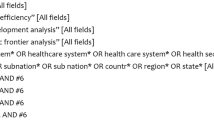Abstract
In Norway, a new system of Activity Based Financing (ABF) for general hospitals was introduced on a comprehensive basis in July 1997. The main purpose of the reform was to increase activity so that more patients could receive treatment more quickly without reducing the quality of care. In this paper we analyse whether the reform has had any significant effect using two different performance indicators: number of patients treated and production of DRG points (Diagnosis Related Group). We divide the hospitals into two groups: hospitals owned by counties that have adopted the ABF system, and hospitals owned by counties using other funding systems. The first group then becomes the experiment group, while the second serves as a comparison group. It is argued that fixed-effect models are suitable specifications for this evaluation study, handling selection bias and the influence of unobservable explanatory variables in a consistent manner. We find that the reform has had a significant effect on the number of patients treated and DRG points produced. The results are sensitive as to how the experiment and the comparison group are determined.
Similar content being viewed by others
References
Abbott, T. A. III (ed.). (1995). Health Care Policy and Regulation. Boston: Kluwer Academic Publishers.
Bradford, W. D. and C. Craycraft. (1996). “Prospective Payments and Hospital Efficiency.” Review of Industrial Organization 11, 791–809.
Carey, K. and J. F. Burgess Jr. (1999). “On Measuring the Hospital Cost/Quality Trade-Off.” Health Economics 8, 509–520.
Ellis, R. P. (1998). “Creaming, Skimping and Dumping: Provider Competition on the Intensive and Extensive Margins.” Journal of Health Economics 17, 537–555.
Ellis, R. P. and T. G. McGuire. (1996). “Hospital Response to Prospective Payment: Moral Hazard, Selection and Practice-Style Effects.” Journal of Health Economics 15, 257–277.
Folland, S., A. C. Goodman and M. Stano. (1997). The Economics of Health and Health Care, 2nd edition. London: Prentice-Hall International.
Gilman, B. H. (2000). “Hospitals Response to DRG Refinements: The Impact of Multiple Reimbursement Incentives on Inpatient Length of Stay.” Health Economics 9(4), 227–294.
Greene, W. H. (1997). Econometric Analysis, 3rd edition. London: Prentice-Hall International.
Ham, C. (2000). Series Editor's Introduction, in Smith, P. C. (ed.). (2000). Reforming Markets in Health Care, An Economic Perspective. Buckingham: Open University Press.
Heckman, J. J. and V. J. Hotz. (1989). “Choosing Among Alternative Nonexperimental Methods for Estimating the Impact of Social Programs: The Case of Manpower Training.” Journal of the American Statistical Association December, 862–880.
Hodgkin, D. and T. G. McGuire. (1994). “Payment Levels and Hospital Response to Prospective Payment.” Journal of Health Economics 13, 1–29.
Magnussen, J. and K. Solstad. (1994). “Case-Based Hospital Financing: The Case of Norway.” Health Policy 28, 23–36.
McClellan, M. (1997). “Hospital Reimbursement Systems: An Empirical Analysis.” Journal of Economics and Management Strategy 3(1), 91–128.
Moffitt, R. (1991). “Program Evaluation with Nonexperimental Data.” Evaluation Review June, 291–314.
Newhouse, J. P. (1996). “Reimbursing Health Plans and Health Providers: Efficiency in Production versus Selection.” Journal of Economic Literature 34, 1236–1263.
OECD. (1992). “The Reform of Health Care–A Comparative Analysis of Seven OECD Countries.” Health Policy Studies No. 2, Paris.
OECD. (1993a). “OECD Health Systems–Facts and Trends 1960-1991.” Health Policy Studies No. 3, Volume 1, Paris.
OECD. (1993b). “OECD Health Systems–The Socio-Economic Environment Statistical References.” Health Policy Studies No. 3, Volume II, Paris.
Pope, G. C. (1989). “Hospital Nonprice Competition and Medicare Reimbursement Policy.” Journal of Health Economics 8, 147–172.
Rogers, W. H., D. Draper, K. L. Kahn, E. B. Keller, L. V. Rubinstein, J. Kosecoff and R. H. Brook. (1990). “Quality of Care Before and After Implementation of the DRG-Based Prospective Payment System–A Summary of Effects.” JAMA 264(15), 1989–1994.
SAMDATA. (1999). Sykehussektoren 1998–fra rammefinansiering til ISF, NIS-rapport 3/99, Trondheim (in Norwegian).
Smith, P. C., A. Stepan, V. Valdmanis and P. Verheyen. (1997). “Principal/Agent Problems in Health Care Systems: An International Perspective.” Health Policy 41, 37–60.
Smith, P. C. (ed.). (2000). Reforming Markets in Health Care, An Economic Perspective. Buckingham: Open University Press.
van der Noord, P.,T. P. Hagen and T. Iversen. (1998). “The Norwegian Health Care System.” Economics Department Working Papers No. 198, OECD.
Author information
Authors and Affiliations
Rights and permissions
About this article
Cite this article
Kjerstad, E. Prospective Funding of General Hospitals in Norway—Incentives for Higher Production?. International Journal of Health Care Finance and Economics 3, 231–251 (2003). https://doi.org/10.1023/A:1026084304382
Issue Date:
DOI: https://doi.org/10.1023/A:1026084304382




